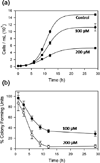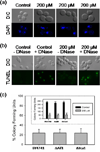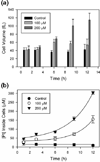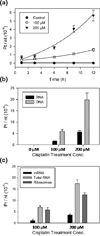RNA-Pt adducts following cisplatin treatment of Saccharomyces cerevisiae
- PMID: 22004017
- PMCID: PMC3262962
- DOI: 10.1021/cb200279p
RNA-Pt adducts following cisplatin treatment of Saccharomyces cerevisiae
Abstract
The numerous regulatory roles of cellular RNAs suggest novel potential drug targets, but establishing intracellular drug-RNA interactions is challenging. Cisplatin (cis-diamminedichloridoplatinum(II)) is a leading anticancer drug that forms exchange-inert complexes with nucleic acids, allowing its distribution on cellular RNAs to be followed ex vivo. Although Pt adduct formation on DNA is well-known, a complete characterization of cellular RNA-Pt adducts has not been performed. In this study, the action of cisplatin on S. cerevisiae in minimal media was established with growth curves, clonogenic assays, and tests for apoptotic markers. Despite high toxicity, cisplatin-induced apoptosis in S. cerevisiae was not observed under these conditions. In-cell Pt concentrations and Pt accumulation on poly(A)-mRNA, rRNA, total RNA, and DNA quantified via ICP-MS indicate ∼4- to 20-fold more Pt accumulation in total cellular RNA than in DNA. Interestingly, similar Pt accumulation is observed on rRNA and total RNA, corresponding to one Pt per (14,600 ± 1,500) and (5760 ± 580) nucleotides on total RNA following 100 and 200 μM cisplatin treatments, respectively. Specific Pt adducts mapped by primer extension analysis of a solvent-accessible 18S rRNA helix occur at terminal and internal loop regions and appear as soon as 1 h post-treatment. Pt per nucleotide accumulation on poly(A)-mRNA is 4- to 6-fold lower than on rRNA but could have consequences for low copy-number or highly regulated transcripts. Taken together, these data demonstrate significant accumulation of Pt adducts on cellular RNA species following in cellulo cisplatin treatment. These and other small molecule-RNA interactions could disrupt processes regulated by RNA.
Figures





References
-
- Sharp PA. The centrality of RNA. Cell. 2009;136:577–580. - PubMed
-
- Thomas JR, Hergenrother PJ. Targeting RNA with small molecules. Chem. Rev. 2008;108:1171–1224. - PubMed
-
- Chow CS, Bogdan FM. A structural basis for RNA-ligand interactions. Chem. Rev. 1997;97:1489–1514. - PubMed
-
- Tor Y. Targeting RNA with small molecules. Chembiochem. 2003;4:998–1007. - PubMed
Publication types
MeSH terms
Substances
Grants and funding
LinkOut - more resources
Full Text Sources
Other Literature Sources
Molecular Biology Databases

